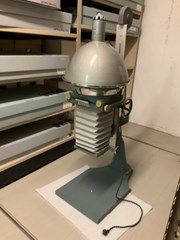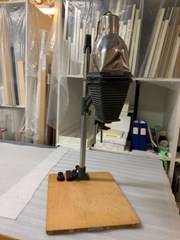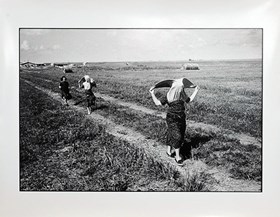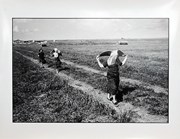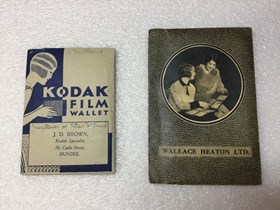Narrow Results By
- Date
- 1950 – 1965
- Material
- metal; plastic; fabric;
- Catalogue Number
- 104.41.0162
- Description
- Large photographic negative enlarger. Mostly made of blue-grey metal, the enlarger consists of a large rectangular base with a support arm rising from the back which holds the enlarging mechanism. Hand-crank wheels on either side of the support arm allows the enlarger to be moved up and down. The t…
1 image
- Title
- Englarger
- Date
- 1950 – 1965
- Material
- metal; plastic; fabric;
- Dimensions
- 140.0 x 40.0 x 74.0 cm
- Description
- Large photographic negative enlarger. Mostly made of blue-grey metal, the enlarger consists of a large rectangular base with a support arm rising from the back which holds the enlarging mechanism. Hand-crank wheels on either side of the support arm allows the enlarger to be moved up and down. The top of the enlarger is a large silver dome [possibly the light] with the black and white fabric-wrapped power cord coming out the top, the dome sits on top of the main blue-grey metal tray where more dials can adjust settings and the tray for inserting the original negative sides out the front, coming out the bottom of the frame is a grey bellows that has the focussing lens on the bottom.
- Subject
- Nicholas Morant
- photography
- photograph equipment
- darkroom
- camera equipment
- photograph developing
- Credit
- Gift of Nicholas Morant, Banff, 2006
- Catalogue Number
- 104.41.0162
Images
This material is presented as originally created; it may contain outdated cultural descriptions and
potentially offensive content.
Read more.
- Date
- 1930 – 1950
- Material
- wood; metal; plastic; glass;
- Catalogue Number
- 104.41.0163
- Description
- Metal Kodak Precision Enlarger mounted on a wooden board with power outlets and power switch mounted beside the base of the enlarger. The support arm mostly consists of a silver metal pole onto which the dull grey metal enlarger support is mounted - a plastic knob on one side allows the enlarger su…
1 image
- Title
- Enlarger
- Date
- 1930 – 1950
- Material
- wood; metal; plastic; glass;
- Dimensions
- 105.0 x 44.5 x 55.7 cm
- Description
- Metal Kodak Precision Enlarger mounted on a wooden board with power outlets and power switch mounted beside the base of the enlarger. The support arm mostly consists of a silver metal pole onto which the dull grey metal enlarger support is mounted - a plastic knob on one side allows the enlarger support to move up and down the support arm. The enlarger itself consists of a shiny metal dome with a fabric-wrapped power cord coming out the top [most likely the house for the light source] mounted on top of the grey metal frame [to which the enlarger support is attached] and into which several different negative trays can be fit, below the frame are dark grey fabric bellows that can be adjusted along a set of metal poles, the bottom of the bellows are attached to a smaller grey metal frame that also houses the focussing lens and a coloured filter that can be rotated in and out of frame.
- Subject
- Nicholas Morant
- photography
- photograph equipment
- camera equipment
- darkroom
- photograph developing;
- Credit
- Gift of Nicholas Morant, Banff, 2006
- Catalogue Number
- 104.41.0163
Images
This material is presented as originally created; it may contain outdated cultural descriptions and
potentially offensive content.
Read more.
Aprons in the Wind
https://archives.whyte.org/en/permalink/artifactweb.18.42
- Artist
- George Webber
- Date
- 1999 – 1999
- Medium
- photograph on paper
- Catalogue Number
- WeB.18.42
- Description
- Three unidentified individuals walking in a field holding aprons over their heads in the wind. Photograph was taken at the Little Bow Hutterite Colony in Southern, Alberta.
1 image
- Artist
- George Webber
- Title
- Aprons in the Wind
- Date
- 1999 – 1999
- Medium
- photograph on paper
- Dimensions
- 11” x 14” cm
- Description
- Three unidentified individuals walking in a field holding aprons over their heads in the wind. Photograph was taken at the Little Bow Hutterite Colony in Southern, Alberta.
- Subject
- documentary photograph
- colony
- Credit
- Gift of George Webber, Calgary, 2014
- Catalogue Number
- WeB.18.42
Images
This material is presented as originally created; it may contain outdated cultural descriptions and
potentially offensive content.
Read more.
Auto Transformer
https://archives.whyte.org/en/permalink/artifact104.41.0110
- Date
- 1950 – 1970
- Material
- metal; plastic
- Catalogue Number
- 104.41.0110
- Description
- Rectangular metal box with rubber knobs on the bottom to keep it off of tabletops, a 0-100 dial, pale yellow circular button, and red light on the top, and four different plugs across the two short sides - one side has one and the other has three. There is a circular hole in the bottom that allows …
1 image
- Title
- Auto Transformer
- Date
- 1950 – 1970
- Material
- metal; plastic
- Dimensions
- 13.5 x 15.1 x 12.6 cm
- Description
- Rectangular metal box with rubber knobs on the bottom to keep it off of tabletops, a 0-100 dial, pale yellow circular button, and red light on the top, and four different plugs across the two short sides - one side has one and the other has three. There is a circular hole in the bottom that allows some limited access to the interior, possibly a vent. Variable Autotransformers are used to control electrical voltage, power, and current so as to provide a safe and steady electrical feed to a device.
- Credit
- Gift of Nicholas Morant, Banff, 2006
- Catalogue Number
- 104.41.0110
Images
This material is presented as originally created; it may contain outdated cultural descriptions and
potentially offensive content.
Read more.
- Date
- 1940 – 1960
- Material
- paper
- Catalogue Number
- 104.41.0134
- Description
- A paper cover book of blotting paper, used during the photographic development process to remove excess moisture from photographs, as well as the option to give the photographs a glazed or unglazed finish.According to the instructions on the cover, one would first blot the photo with the interleave…
1 image
- Title
- Blotter Book
- Date
- 1940 – 1960
- Material
- paper
- Dimensions
- 2.1 x 29.5 x 22.2 cm
- Description
- A paper cover book of blotting paper, used during the photographic development process to remove excess moisture from photographs, as well as the option to give the photographs a glazed or unglazed finish.According to the instructions on the cover, one would first blot the photo with the interleaved blotting paper pages and then, for a glazed finish, turn the photo over to face the alternating wax paper or, for an unglazed finish, leave it facing the blotting paper and then place a weight on the book and let it set.
- Credit
- Gift of Nicholas Morant, Banff, 2006
- Catalogue Number
- 104.41.0134
Images
This material is presented as originally created; it may contain outdated cultural descriptions and
potentially offensive content.
Read more.
- Date
- 1940 – 1970
- Material
- leather; fabric; metal; glass; plastic; paper
- Catalogue Number
- 104.41.0094 a-g
- Description
- Black leather hard-sided travel case with wooden runners along the bottom, brackets for a strap on both short sides, a hard leather/wooden handle on the lid (attached with metal loops), and a hinged lid with three clasps - the centre one of which has a keyhole. The exterior of the case has several …
1 image
- Title
- Camera Case
- Date
- 1940 – 1970
- Material
- leather; fabric; metal; glass; plastic; paper
- Dimensions
- 31.8 x 24.9 x 42.8 cm
- Description
- Black leather hard-sided travel case with wooden runners along the bottom, brackets for a strap on both short sides, a hard leather/wooden handle on the lid (attached with metal loops), and a hinged lid with three clasps - the centre one of which has a keyhole. The exterior of the case has several torn and scuffed travel labels and stickers, as well as various paper travel tags attached to the lid handle and side brackets with pieces of string. The interior of the case is divided into five separate compartments and is lined in purple velvet - the interior of the lid is also divided into two velvet-lined compartments held closed with hinged doors and leather tabs/snaps. The contents of the case have been divided into six categories:b : camera and alternate lenses. Includes a black and silver Graflex Speed camera with a lens mounted on rails that slides forward and back with soft leather bellows and a viewfinder on top and a leather handle on one side. There are also two alternate regular lenses (one in a blue cardboard box with “SCHNEIDER OPTIK KREUZNACH” embossed in silver on the lid, and the other in a red velvet bag) and an expandable bellows lens with a yellow-tinted lens. Also included is a metal gauge used to determine the camera’s F stop that mounts to the top of the camera, housed in a red box with “LEITZ Germany Entfernungsmesser ‘Fokos’” embossed in gold on the lid. c : flash accessories. Includes two shiny silver lens cones (one of which is housed in a black fabric bag), two different handles - one of which is possibly an extender - housed in separate blue corduroy bags, two bulb mounts that attach the handles to the cones/bulbs (one made of black plastic and the other of black and grey metal) housed in a leopard-print fabric bag, a collection of cords and plugs used to attach the flash to the camera (one of which is housed in a small dark blue velvet bag), and three flashbulbs - two of which are clear but different sizes and the third is blue. d : various filters. Includes a total of 18 different filters, usually yellow, as well as four alternate view finders. All lenses are housed in containers, including black and yellow plastic Kodak cases, a red metal first-aid kit tin, and brown leather pouches that snap closed. Six filters and a short black spiral cord is housed in a small black leather box with a lid that snaps closed.e : slide magazines. Two black Graflex slide magazines to hold 4x5 negatives, as well as an extra magazine back (with a leather strap and snap) in a paper sleeve.f : various manuals. Manuals for various camera equipment/camera settings, some of which were tucked into a brown leather envelope. g : miscellaneous tools. Includes a brown leather pouch that contains a small pocket mirror (in a decorative leather sleeve embossed with gold), nail clippers, and tweezers, a block of wood with a small hole in the centre and “Triple Camera Mount Accessory. Spacer for WA Lense” typed on a sticker on the side painted white, two metal hoops that are possibly also spacers (one of which is adhered to a circular piece of paper), various screws, two small screwdrivers with yellow handles, a yellow plastic pouch with five tiny screwdrivers, and a ballpoint pen.
- Credit
- Gift of Nicholas Morant, Banff, 2006
- Catalogue Number
- 104.41.0094 a-g
Images
This material is presented as originally created; it may contain outdated cultural descriptions and
potentially offensive content.
Read more.
- Date
- 1975 – 1989
- Material
- plastic; paper; cardboard
- Catalogue Number
- 104.41.0111
- Description
- Black and grey plastic “Pocket Strobe” flash attachment in original black cardboard box - also in the box are the instruction manuals and two small plastic mounting tools. On the back of the flash is the on/off switch, a ready lamp light, directions for distances depending on colour or black and wh…
1 image
- Title
- Camera Flash
- Date
- 1975 – 1989
- Material
- plastic; paper; cardboard
- Dimensions
- 7.5 x 7.9 x 11.1 cm
- Description
- Black and grey plastic “Pocket Strobe” flash attachment in original black cardboard box - also in the box are the instruction manuals and two small plastic mounting tools. On the back of the flash is the on/off switch, a ready lamp light, directions for distances depending on colour or black and white film, and the opening for batteries.
- Credit
- Gift of Nicholas Morant, Banff, 2006
- Catalogue Number
- 104.41.0111
Images
This material is presented as originally created; it may contain outdated cultural descriptions and
potentially offensive content.
Read more.
- Date
- 1960 – 1980
- Material
- metal; plastic; paper; glass;
- Catalogue Number
- 104.41.0119 a-g
- Description
- Rectangular shiny silver metal box with a lift-off lid. Contents of the box include two glass vignettes with edges wrapped in pale brown binding tape [one has a small tab on one side], a yellow-tinted “KODAK SERIES VI ADAPTER RING” mounted in metal, a circular black plastic “CRAFTMEN’S GUILD PICTOR…
1 image
- Title
- Equipment Box
- Date
- 1960 – 1980
- Material
- metal; plastic; paper; glass;
- Dimensions
- 5.1 x 11.7 x 21.0 cm
- Description
- Rectangular shiny silver metal box with a lift-off lid. Contents of the box include two glass vignettes with edges wrapped in pale brown binding tape [one has a small tab on one side], a yellow-tinted “KODAK SERIES VI ADAPTER RING” mounted in metal, a circular black plastic “CRAFTMEN’S GUILD PICTORAL CONTROL” fixture with a clear central hole, a thin grey cardboard Kodak box with a strip of paper adhesive tape wrapped around the box holding the lid closed that has “2 1/4 x 3 1/4 Glasses for A - Assembly Enlarger” in blue ink [most likely written by Morant], a second thin Kodak cardboard box with a paper adhesive tape on the lid that has “MASKS for PRECISION A” written in black ink [probably by Morant] that contains wax paper envelopes of coloured celluloid masks, and a paper Canadian Pacific Railway envelope that contains wax paper envelopes of coloured celluloid masks.
- Credit
- Gift of Nicholas Morant, Banff, 2006
- Catalogue Number
- 104.41.0119 a-g
Images
This material is presented as originally created; it may contain outdated cultural descriptions and
potentially offensive content.
Read more.
- Date
- 1930 – 1931
- Material
- paper;
- Catalogue Number
- 104.41.0219 a,b
- Description
- Two paper folding envelopes for holding film and/or developed prints - one is Kodak and one is from Wallace Heaton Ltd., a developing studio in London England. Both wallets fold open to show two open-sided pouches where either films or prints could be slotted and have advertising for other services…
1 image
- Title
- Film Wallet
- Date
- 1930 – 1931
- Material
- paper;
- Dimensions
- 0.3 x 11.3 x 16.7 cm
- Description
- Two paper folding envelopes for holding film and/or developed prints - one is Kodak and one is from Wallace Heaton Ltd., a developing studio in London England. Both wallets fold open to show two open-sided pouches where either films or prints could be slotted and have advertising for other services/products printed on them. The Kodak wallet is predominantly white and blue, has a small slip of paper that appears to have “13/5/30 [?] Winton” and several numbers written on it in pencil, several numbers written in pencil on the left-hand side inside, and “Scotland / Negatives of Pete’s Scotland” written in black ink by Catharine Whyte on the front cover. The Wallace Heaton wallet is predominantly grey and black with a picture of two women looking at a photo album on the front cover, a slip of paper that appears to be a receipt for the Browns Hotel made out to “Nice Esq” tucking inside, “Scotland / Nice Esq / egative Scotland 1930” written in different hands on the back [everything except “Nice Esq” written by Catharine Whyte].
- Credit
- Gift of Catharine Robb Whyte, O. C., Banff, 1979
- Catalogue Number
- 104.41.0219 a,b
Images
This material is presented as originally created; it may contain outdated cultural descriptions and
potentially offensive content.
Read more.
- Date
- 1960 – 1979
- Material
- paper; plastic
- Catalogue Number
- 104.41.0108
- Description
- 31 individual Moiré filters in wax paper envelopes with instruction manuals in a repurposed Ansco Photographic Paper box. Filters are in various patterns and shapes and are coloured either black, pink, yellow, or teal.Moiré filters were used in developing photographs to create textured blocks of co…
1 image
- Title
- Filters
- Date
- 1960 – 1979
- Material
- paper; plastic
- Dimensions
- 2.1 x 21.3 x 26.2 cm
- Description
- 31 individual Moiré filters in wax paper envelopes with instruction manuals in a repurposed Ansco Photographic Paper box. Filters are in various patterns and shapes and are coloured either black, pink, yellow, or teal.Moiré filters were used in developing photographs to create textured blocks of colour in order to enhance printed images, usually in advertisement. Moiré patterns are made by overlapping fine-line patterns (such as pinstripes) that are offset from each other at a slight angle - these patterns will appear and disappear depending on the resolution they appear in.
- Credit
- Gift of Nicholas Morant, Banff, 2006
- Catalogue Number
- 104.41.0108
Images
This material is presented as originally created; it may contain outdated cultural descriptions and
potentially offensive content.
Read more.


